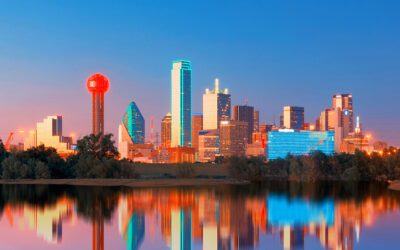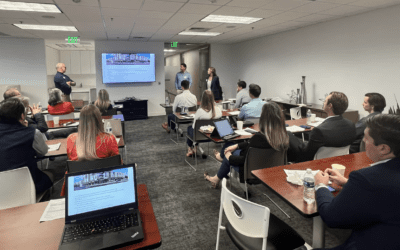The mass adoption of remote and hybrid work since 2020 has led to weak demand for commercial office space, but not only in urban cores and central business districts (CBD). Office buildings in suburban areas and halo cities are reporting alarming vacancy rates, which could lead to loan defaults, foreclosures, and eroding property values. And from a commercial real estate perspective, market demand for these properties in their current designated use state is not expected to increase. Obviously, this is a problem financially for both owners and operators as well as the cities where these buildings are located.
So, how did we get here, and why are there so many properties that are underperforming?
While the majority of midsize and grocery-anchored strip-mall retail has rebounded since the pandemic – 5,000 square-foot spaces are now at 96% leased – the commercial office category will not reflect that same level of rebound.
In a Dallas Morning News article, Steve Brown notes that more than 70 million square feet of office space is vacant in Dallas-Fort Worth, including sublease space – the largest amount of vacancies in decades. Only 33% of direct space on the market is in blocks over 100,000 square feet, demonstrating how many large companies have shed space since the pandemic in light of remote and hybrid work. This means the majority of vacant office space is in small and midsize buildings, many located outside the CBD.
We’re looking at suburban commercial office properties that are 50,000-250,000 square feet with 50% vacancy. These 2-3 story buildings with a dozen acres of surface park were built decades ago on the suburban edges of density to attract and establish new companies in the area. Dotting the suburbs with these 200,000 square-foot office buildings gave companies space to office in areas convenient to schools, homes, and areas people wanted to live. Now those cities have grown and expanded far beyond these building locations, such as Richardson, Plano, South Dallas, Garland, Carrollton, and more.
In the 1980s, there was a cavalier building boom in the suburbs and developers were willing to throw anything up and see if it worked in attracting businesses and people. These young suburban areas with new office buildings close to schools, amenities, and single-family housing were attractive to companies relocating to the area. They could more easily attract the labor force that was there at that time.
But now there’s little reason to return to these older inefficient buildings, especially as many companies that formerly occupied these spaces have decided to save money by going fully remote. What type of company wants to repurpose the building when so much work likely needs to go into it?
Cities are beginning to look at ways to convert these vacant and mostly vacant buildings, increase occupancy, and improve efficiency. If there is no demand for office space in these areas, what building types ARE in demand? One large office space at Legacy Drive in Plano, the former Electronic Data Systems headquarters, is planned for a conversion into a life science and medical research center.
Taking a closer look at properties that are underperforming, we can build off of the quality things that exist around it to regenerate the area. By removing excess office space and replacing it with mixed-use, we’re helping cities to reinvest in communities by supplying the property types most in demand, like housing and small retail.
From a broker’s perspective, in evaluating these vacant properties, they’re not as desirable for the same purpose anymore. In fact, certain cities and properties are in dire need of revitalization because the area itself is desirable or up and coming. It’s a great spot, affordable and convenient for Millennials who really love the quality of life they find there.
What makes these properties primed for rethinking is they have all the right things going for them – a location near existing density, lifestyle amenities, major employers and neighborhoods where people want to live. Often, there hasn’t been vacant land in these areas for decades. We’re providing suburban infill solutions by taking one kind of square footage off market and creating demand for the remaining buildings. By removing competitive office space and taking 300,000 square feet off the market, all those other buildings around it that need occupants can be filled with workers.
A report from the National Bureau of Economic Research [link to report online] makes the case for incentivizing the conversion of “brown office buildings class B/C” to green apartments that preserve asset value and create mixed-use and residential housing to address a number of issues that result from the “urban doom loop” as the authors call it. Rehabilitating existing buildings not only addresses the misallocation of space in suburban areas, it produces up to 50-70% fewer carbon emissions than new construction.
We’re prepared to take a macro look at each city individually, identify underperforming buildings, and create a plan for redevelopment. Where can we increase existing office occupancy as well as housing where amenities and demand are already in place? Our goal is to help cities regenerate communities with considerations for energy efficiency, density, purpose and upzoning for a proper mix of property types.
When pressure is applied to these cities to do something with the glut of office space, we begin to see more municipality-led measures to shrink that inventory, such as incentives to make it easier to convert or redevelop an office building, or recognizing that the land underneath these outdated office buildings is more valuable in a land-constrained market to demolish the building in favor of constructing a new project.
We help identify buildings suitable for conversion, redevelopment or upzoning, evaluate the property and site, and together create a proforma that makes the highest and best use of the site.
Tom Metcalfe is a leader and innovator in Dallas-Fort Worth commercial real estate. With 44 years of experience under his belt, his market expertise and insights on demand, development and financing bring clients immense value.
Related Articles
Unlocking Dallas’s Potential: Navigating the Future of Commercial Real Estate
Delve into the heart of Dallas's commercial real estate scene with our latest presentation featuring insights from Dallas Cothrum, President of Masterplan, A Milrose Company. With over two decades of experience and an intimate knowledge of the dynamic Dallas market,...
Empowering Real Estate Developers: Exploring C-PACE Financing for Adaptive Reuse Projects
Embark on a journey into the world of innovative financing solutions for large-scale adaptive reuse projects with insights from Julianna Brooks, President of Civitas PACE Finance. In our latest presentation, Brooks unveils the transformative potential of C-PACE...
Unlocking the Future: Exploring Trends in the Multi-Family Rental Market
Unlock the keys to the evolving landscape of the multi-family rental market with our recent presentation on the latest trends. Delving into the dynamic preferences of Millennials and Gen Z, who collectively make up a significant portion of the renting population, we...




